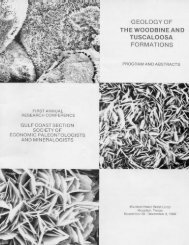Petroleum Systems of Deep-Water Basins - Gulf Coast Section SEPM
Petroleum Systems of Deep-Water Basins - Gulf Coast Section SEPM
Petroleum Systems of Deep-Water Basins - Gulf Coast Section SEPM
You also want an ePaper? Increase the reach of your titles
YUMPU automatically turns print PDFs into web optimized ePapers that Google loves.
Kinematic Evolution <strong>of</strong> the <strong>Gulf</strong> <strong>of</strong> Mexico<br />
and Caribbean<br />
James Pindell<br />
Tectonic Analysis, Ltd.<br />
Cokes, Barn, West Burton<br />
West Sussex RH20 1HD<br />
England<br />
Also, Dept. Earth Science, Rice University, Houston, Texas, USA<br />
e-mail: jim@tectonicanalysis.com<br />
Lorcan Kennan<br />
Tectonic Analysis, Ltd.<br />
Cokes, Barn, West Burton<br />
West Sussex RH20 1HD<br />
England<br />
Abstract<br />
We present a series <strong>of</strong> 14 updated tectonic reconstructions for the <strong>Gulf</strong> <strong>of</strong> Mexico and Caribbean region since the<br />
Jurassic, giving due attention to plate kinematic and palinspastic accuracy. Primary elements <strong>of</strong> the model are<br />
1. A re-evaluation <strong>of</strong> the Mesozoic break-up <strong>of</strong> Pangea, to better define the Proto-Caribbean passive margin elements,<br />
the geology and kinematics <strong>of</strong> the Mexican and Colombian intra-arc basins, and the nature <strong>of</strong> the early<br />
Great Caribbean Arc;<br />
2. Pre-Albian circum-Caribbean rock assemblages are reconstructed into a primitive, west-facing, Mexico-Antilles-<br />
Ecuador arc (initial roots <strong>of</strong> Great Caribbean arc) during the early separation <strong>of</strong> North and South America;<br />
3. The subduction zone responsible for Caribbean Cretaceous HP/LT metamorphic assemblages was initiated during an<br />
Aptian subduction polarity reversal <strong>of</strong> the early Great arc; the reversal was triggered by a strong westward acceleration<br />
<strong>of</strong> the Americas relative to the mantle which threw the original arc into compression (Pindell et al., in press);<br />
4. The same acceleration led to the Aptian-Albian onset <strong>of</strong> back-arc closure and “Sevier” orogenesis in Mexico, the<br />
western USA, and the northern Andes, making this a nearly hemispheric event which must have had an equally<br />
regional driver;<br />
5. Once the Great Caribbean arc became east-facing after the polarity reversal, continued westward drift <strong>of</strong> the<br />
Americas, relative to the mantle, caused subduction <strong>of</strong> proto-Caribbean lithosphere (which belonged to the American<br />
plates) beneath the Pacific-derived Caribbean lithosphere, and further developed the Great arc;<br />
6. Jurassic-Lower Cretaceous, “Pacific-derived,” Caribbean ophiolite bodies were probably dragged and stretched<br />
(arc-parallel) southeastward during the Late Jurassic to Early Cretaceous along an (Aleutian-type) arc spanning<br />
the widening gap between Mexico and Ecuador, having originated from subduction accretion complexes in western<br />
Mexico;<br />
7. A Kula-Farallon ridge segment is proposed to have generated at least part <strong>of</strong> the western Caribbean Plate in<br />
Aptian-Albian time, as part <strong>of</strong> the plate reorganisation associated with the polarity reversal;<br />
8. B” plateau basalts may relate to excessive Kula-Farallon ridge eruptions or to now unknown hotspots east <strong>of</strong> that<br />
ridge, but not to the Galapagos hotspot;<br />
9. A two-stage model for Maastrichtian-early Eocene intra-arc spreading is developed for Yucatán Basin;<br />
10. The opening mechanism <strong>of</strong> the Grenada intra-arc basin remains elusive, but a north-south component <strong>of</strong> extension<br />
is required to understand arc accretion history in western Venezuela;<br />
11. Paleocene and younger underthrusting <strong>of</strong> Proto-Caribbean crust beneath the northern South American margin predates<br />
the arrival from the west <strong>of</strong> the Caribbean Plate along the margin; and<br />
12. Recognition <strong>of</strong> a late middle Miocene change in the Caribbean-North American azimuth from east to east-northeast,<br />
and the Caribbean-South American azimuth from east-southeast to east, resulted in wholesale changes in tectonic<br />
development in both the northeastern and southeastern Caribbean Plate boundary zones.<br />
9

















